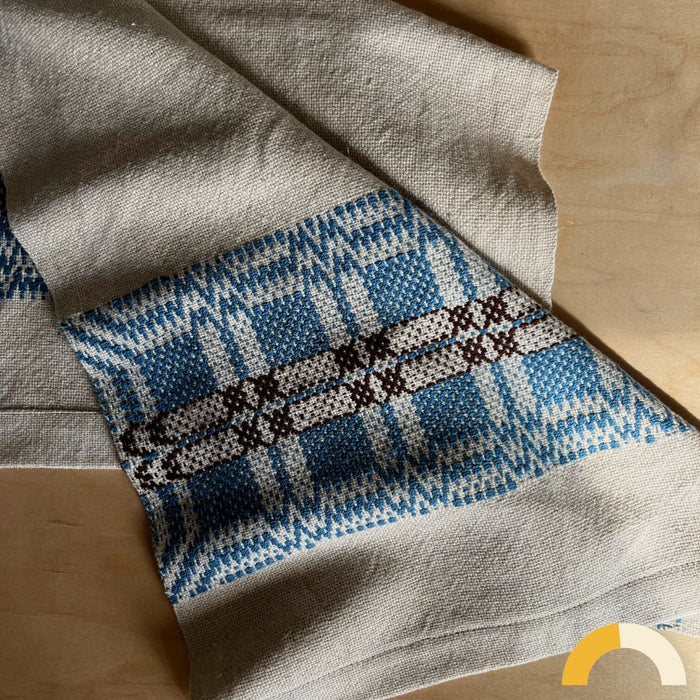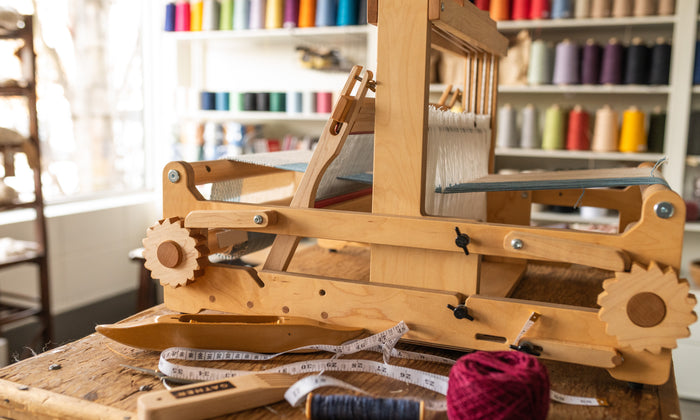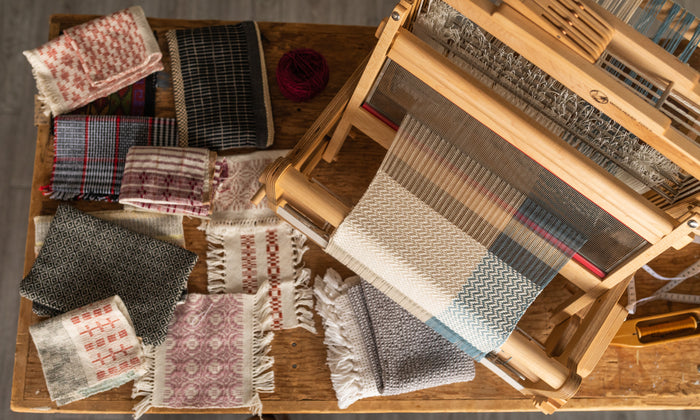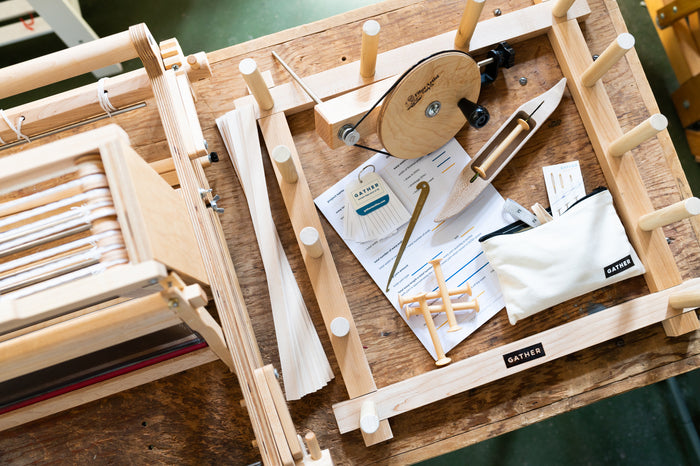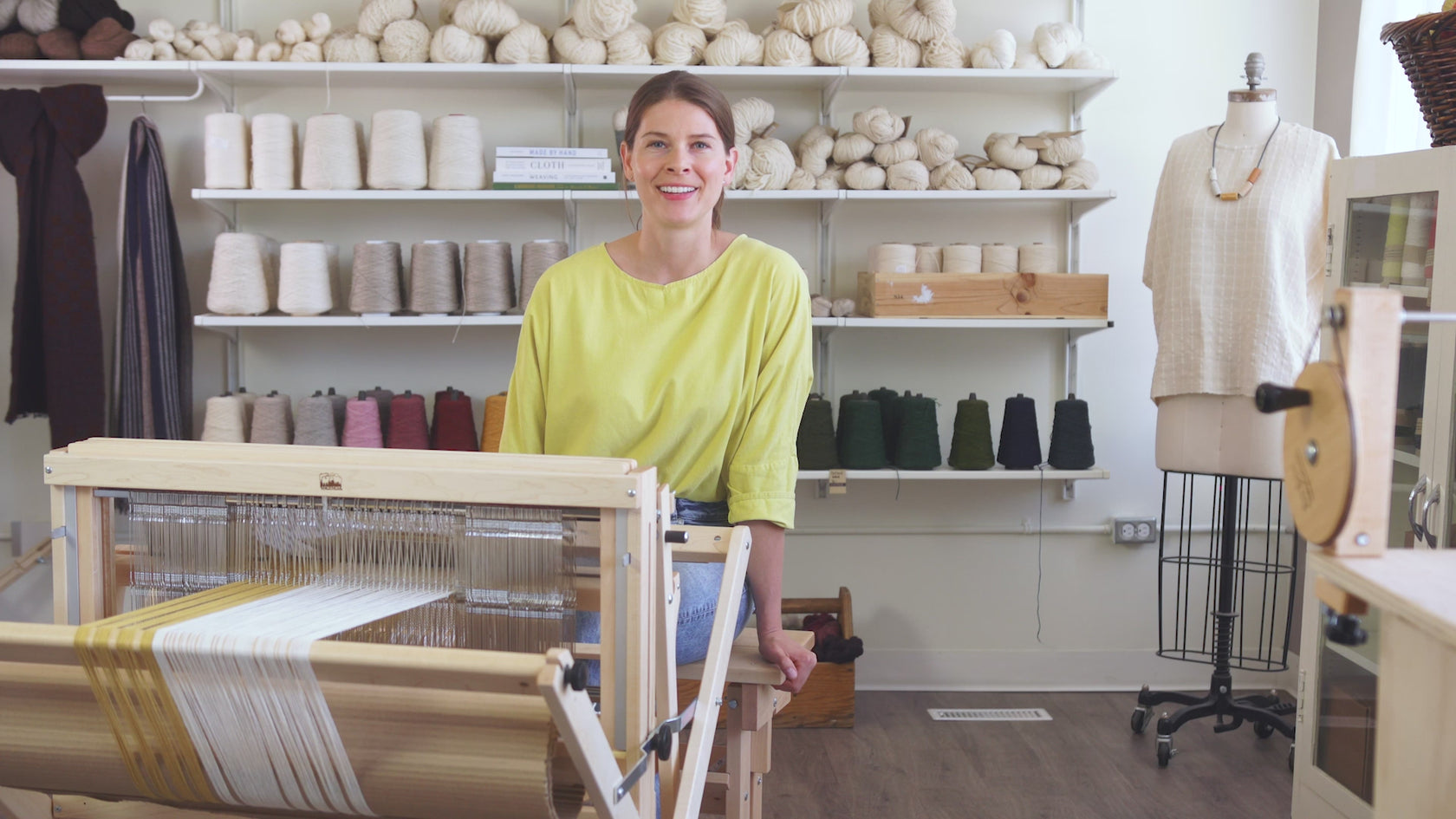Learning to weave is like learning a new language. Check out our comprehensive list of commonly used weaving terms.

Apron Rod: A thin metal or wooden rod that is attached to your cloth beam orwarp beam. The apron rod is what you actually tie your warp onto.
Apron Cloth: The canvas cloth connecting a beam to an apron rod. In newer looms, texsolv cords are often used instead.
Balanced Weave or 50/50 Weave: A weave with the same number of warp threads in a given inch of warp (epi) and weft threads in a given inch of weft (ppi).
Beaming: Putting your warp on your back beam on your loom using lease sticks, raddle and warping sticks or cardboard.
Beat: To beat a pick of weft is to press it in place using your beater. A weaver’s beat is how firmly or softly they beat the weft (e.x. “Use a heavy beat for this project.”)
Bobbin: A small wooden or plastic tube that holds all your thread to load into your shuttle for weaving.
Block Weaves: Weave structures that use repeated blocks of warp threadings bound by particular rules. Includes overshot, crackle, summer and winter, Ms and Os, huck lace and spot lace.
Brook’s Bouquet: A finger manipulation technique where the weft is wrapped around bundles of warp threads to create openings in the weave.
Castle: The horizontal piece of wood running above the shafts on many looms.
Choke Tie: Temporary tight tie around the warp to hold all the ends in place when moving from the warping board to the loom.
Closed Shed: When no shed is open and all warp threads are at the same height.
Cloth Beam: The wooden beam at the front of you loom where cloth builds up as a warp is woven.
Colour-and-Weave: A technique where both warp and weft go back and forth between two colours in a set pattern to create a visual effect. Both houndstooth and log cabin are colour-and-weave patterns.
Counterbalance Loom: A loom with paired shafts where a shed is created by lowering some shafts, automatically raising others.
Countermarche Loom: A loom where sheds are created by raising some shafts and lowering others simultaneously. Unlike with counterbalance looms, each shaft moves independently.
Counting Thread: A piece of thread that is wrapped around each inch of warp threads during winding. This is used in your weavers cross to keep track of the number of ends you have in your warp.
Cramming and Denting: How you distribute your warp in your reed. Cramming is condensing multiple ends in a reed and denting is spacing them out to get different effects.
Dent: A slot in the reed. Reeds can have different numbers of dents per inch.
Direct Warping: A method of warping rigid heddle looms where the warp is strung out between a warping peg and the apron rod of the loom instead of being measured on a board or mill.
Draft: Diagram or “pattern” representing the threading, tie up and treadling required to create your weaving. This will tell you the information you need to weave.
Draw-Down: This part of your draft shows you what the warp and weft interlacement will look like. It looks like a piece of graph paper, with squares filled in to indicate where warp threads pass over weft threads.
Draw-In: The narrowing of the weaving at the selvedge due to the weft going over and under the warp yarn. All weaving has draw-in to some degree. Excessive draw-in can happen when the weft is placed in too tight.
Double Weave: A structure where two layers are woven at the same time. The layers can be joined on both sides to make a tube, exchanged with each other to make a dense cloth, or joined on one side to make double-width cloth
E.P.I.: Ends Per Inch: the number of warp ends in one inch of weaving. The E.P.I. determines the sett.
Ends: One warp thread is called one end.
Fell Line: The edge of the weaving where the last weft has been beaten into place.
Float: Any place where a warp thread goes over more than one weft thread (warp float) or a weft thread goes over more than one warp thread (weft float). The term ‘max float’ refers to the longest float produced by a given draft.
Floating Selvedge: A warp end at the selvedge that is not threaded through a heddle, to ensure that each pick of weft is always anchored at the selvedge. Often used when weaving twill.
Fulling: The controlled, partial felting of wool during wet-finishing to add stability and body to woven cloth.
Header: First inch or so of weaving that balances all your warp threads evenly. This is discarded after but is helpful to start your weaving.
Hemstitching: A technique for securing the beginning and end of a piece by wrapping a long weft tail around bundles of warp ends.
Heddles: Thin pieces of metal or texsolv that are held by a shaft. They have a hole in the center through which you can thread a warp end. Lifting a shaft raises all warp ends threaded through heddles on that shaft.
Jack Loom: A loom where a shed is created by lifting shafts above the resting line of the warp.
Lamm: Lamms are pieces of wood that is attach to the treadles (foot pedals) via the tie up cords or treadle cords. They lift or lower shafts when a treadle is pressed.
Lashing On: An alternative to tying on. Lashing on involves tying warp ends into small bundles, and then ‘lashing’ a strand of waste yarn through each bundle and around the apron rod to place tension on the warp.
Lease Sticks: These are used to separate your weavers cross when moving your warp from your warping board or mill to the loom.
Leno: A finger manipulation technique where warp ends are crossed over each other to create lacey openings.
Loom Waste: Length of warp that cannot be woven with when you get to the end of your warp.
Open Shed: When some warp ends are lifted or lowered to create an opening, the shed is open. Many sources will tell you to beat on an ‘open shed’, meaning to hold your treadle down so that the warp threads remain parted while you beat.
Overshot: A family of weave structures using a tabby ground with a supplemental pattern weft. Overshot drafts are designed in blocks, which create complex star and flower designs.
P.P.I.: Picks Per Inch: the number of weft picks in one inch of weaving
Pick: One pass of weft thread through a shed is called a pick.
Pick up Stick: A flat wooden stick used to manipulate warp threads to intentionally create floats. Often used with rigid heddle looms.
Plain Weave: The simplest weave structure, where each pick of weft goes over one warp thread, then under the next.
Profile Draft: A simplified way of writing block drafts where squares represent pattern blocks rather than individual interlacements of warp and weft.
Raddle: This is an open “comb” used to separate the warp when you’re beaming it. Typically it separates your warp into 1/2 inch or 1 inch sections.
Reed: A metal grill that sits inside your beater bar. The reed is used to separate and evenly space your warp threads. It is also used as a guide for your shuttle to motion across the shed.
Rigid Heddle Loom: A loom where the heddle, beater, and reed have been combined into a solid plastic comb or rigid heddle reed. Rigid heddle looms are the equivalent of two-shaft looms.
Rising Shed Loom: Looms where the shed is created by raising some warp ends (i.e. jack looms and table looms). Most new drafts are written for rising shed looms.
Sectional Beam: A warp beam that is divided into multiple ‘sections’ with metal brackets or wooden pegs.
Selvedge: The edge of your woven cloth. There is a selvedge on both the left and the right as you weave. Selvedge sometimes also refers to the final warp end on either side--see ‘floating selvedge’ above.
Sett: The number of warp ends per inch (epi). The sett determines the overall density of your warp.
Shaft: This is also known as the harness. It is the frame that holds the heddles. Four-shaft looms have four separate frames, which can be lifted together or separately to create different weave structures.
Shed: The opening created when the shafts are lifted. This is where your throw your shuttle through.
Shot: See "Pick"
Shrinkage: The percentage of size change that happens once your cloth is wet finished.
Shuttle: A tool for carrying weft through the shed. Boat shuttles, the most common style, have a horizontal metal rod for holding a bobbin surrounded by a wooden ‘boat’. There are other styles of shuttles for specialized tasks (e.x. rag shuttles, stick shuttles)
Sinking Shed Loom: Looms where the shed is created by lowering warp ends (i.e. counterbalance looms). Many drafts from the early 20th century were written for sinking shed looms.
Skip: An unintentional float
Sleying: Sleying refers to threading warp ends through the reed.
Sley Hook: A long, thin metal hook used for threading your heddles and sleying your reed.
Supplemental Warp/Supplemental Weft: A warp or weft is considered “supplemental” when it adds extra detail or pattern to the surface of a weave structure, but does not play a functional role in holding the structure together.
Surgeon’s Knot: A knot used to secure bundles of warp ends when tying on. To tie a surgeon’s knot, cross two bundles of thread and tuck one under the other, like you do when you begin tying your shoes. Then tuck that end under a second time. This creates more grip so that the knot remains in place under tension.
Tabby: Plain weave (see above). Often used in weaving drafts to indicate that a pick of plain weave must be woven between each pick of pattern weft (“use tabby”).
Take-Up: The amount of length lost in your warp due to the warp ends needing to travel over and under the weft picks.
Tapestry Needle: A large, blunt needle used by weavers for hemstitching and weaving in ends.
Tapestry Weaving: A style of weft-faced weaving where colourful warp threads are used to make figurative designs. Normally woven on a frame loom.
Tension: How tightly warp threads are help by the loom. Threads under firm tension are taut, like guitar strings.
Texsolv: Type of polyester cord that is crocheted with no knots. It is used for tie ups, heddles and break cords on some looms.
Threading: The process of putting your warp threads through your heddles. Typically you refer to the draft to determine your threading sequence.
Tie Up: The combinations of treadles that you connect to each shaft on a floor loom, and the order in which you connect those treadles. This also refers to the combination of shafts that you lift together on a table loom.
Treadle: A foot pedal on a floor loom.
Treadling: The order in which you press the treadles (foot pedals) to lift the shafts according to your draft.
Twill: A family of weave structures where each warp thread travels over and then under weft threads in a set ratio (in 2/2 twill, each end goes over two threads then under two threads; in 3/1 twill, each end goes over three, then under one). The pattern shifts over one end in each pick, making diagonal lines.
Tying On: When you tie all of your warp on to your apron rod before you begin to weave.
Warp: Your warp consists of the threads held under tension on your loom. These threads run the length of the piece.
Warp Beam: The wooden beam at the back of a loom that the warp threads are wound around until they are ready to be woven.
Warp-Faced: Weaving structures where the warp is more visible than the weft, such as rep weave, are warp-faced.
Warping Board: Is used to make a warp on a frame style board with pegs. The board is stationary and the warp is made by winding back and fourth from peg to peg. Typically the longest warp is 13 yards on a board and then you must move to a mill for longer warps.
Warping Mill: Is used to create a warp on a reel. It is adjustable for different sizes of warps.
Warping Sticks: A form of warp separator placed between layers of warp as it is beamed. Compared to paper or cardboard, they create even tension on the warp and are less likely to move around on your back beam.
Weavers Cross: The cross keeps your threads in proper order so that they do not overlap when beaming your warp. The weavers cross is a very important element of your warp!
Weft: The threads that weave between the warp threads. They are perpendicular to the selvedge and run horizontally on the cloth.
Weft-Faced: Weaving structures where the weft is more visible than the warp, such as traditional rug weaving, are weft-faced.
Wet Finishing: Washing your finished weaving to help the warp and weft bind as cloth. This typically involves soap and water.

